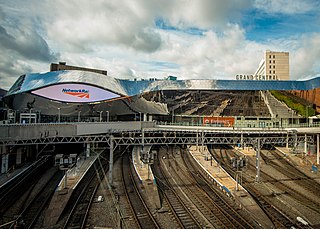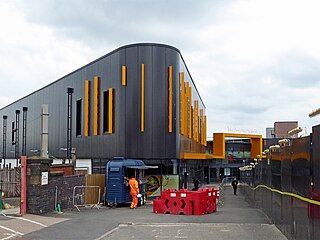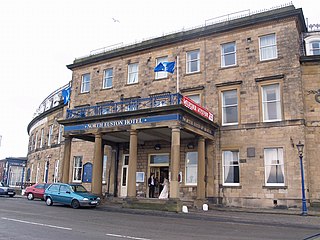


Ray L Moorcroft FRIBA was chief architect for British Rail from 1977, and is best known for his work on the passenger hall of Euston railway station.



Ray L Moorcroft FRIBA was chief architect for British Rail from 1977, and is best known for his work on the passenger hall of Euston railway station.
Moorcroft started with British Rail as an architect in the London Midland Region, working with William Robert Headley. He succeeded Bernard Kaukas as Chief Architect to British Rail in 1977, when Kaukas was appointed Director of Environment.

Euston railway station is a central London railway terminus in the London Borough of Camden, managed by Network Rail. It is the southern terminus of the West Coast Main Line, the UK's busiest inter-city railway. Euston is the eleventh-busiest station in Britain and the country's busiest inter-city passenger terminal, being the gateway from London to the West Midlands, North West England, North Wales and Scotland.

Birmingham New Street is the largest and busiest of the three main railway stations in Birmingham city centre, England, and a central hub of the British railway system. It is a major destination for Avanti West Coast services from London Euston, Glasgow Central and Edinburgh Waverley via the West Coast Main Line, the CrossCountry network, and for local and suburban services within the West Midlands; this includes those on the Cross-City Line between Lichfield Trent Valley, Redditch and Bromsgrove, and the Chase Line to Walsall and Rugeley Trent Valley. The three-letter station code is BHM.

Birmingham International is a railway station located in Solihull in the West Midlands, to the east of the city of Birmingham, England.

Manchester Oxford Road railway station is a railway station in Manchester, England, at the junction of Whitworth Street West and Oxford Street. It opened in 1849 and was rebuilt in 1960. It is the second busiest of the four stations in Manchester city centre.

Philip Hardwick was an English architect, particularly associated with railway stations and warehouses in London and elsewhere. Hardwick is probably best known for London's demolished Euston Arch and its twin station, the original Birmingham Curzon Street, which stands today as the oldest railway terminus building in the world.

The Euston Arch, built in 1837, was the original entrance to Euston station, facing onto Drummond Street, London. The arch was demolished when the station was rebuilt in the 1960s, but much of the original stone was later located—principally used as fill in the Prescott Channel—and proposals have been formulated to reconstruct it as part of the planned redevelopment of the station, including the station's use as the London terminus of the High Speed 2 line.

Stafford railway station is a major interchange railway station in Stafford, Staffordshire, England, and is the second busiest railway station in Staffordshire, after Stoke-on-Trent. The station serves the county town, as well as surrounding villages. The station lies on the junction of the Trent Valley Line, the Birmingham Loop/Rugby-Birmingham-Stafford Line, and the West Coast Main Line.

Wolverhampton railway station in Wolverhampton, West Midlands, England is on the Birmingham Loop of the West Coast Main Line. It is served by Avanti West Coast, CrossCountry, Transport for Wales and West Midlands Trains services, and was historically known as Wolverhampton High Level.

Gobowen railway station is a railway station on the Shrewsbury to Chester Line of the former Great Western Railway's London Paddington to Birkenhead Woodside via Birmingham Snow Hill line, serving the village of Gobowen in Shropshire, England. It is the nearest station to the town of Oswestry.

Chelford railway station serves the village of Chelford in Cheshire, England. The station is 14+1⁄4 miles (22.9 km) north of Crewe on the Crewe to Manchester Line.
Edwin Dolby was an English Victorian architect who practised in Abingdon. His works include the design of Abingdon School.
Charles Trubshaw FRIBA was an architect specifically associated with railway buildings on the London and North Western Railway and Midland Railway lines.

The North Euston Hotel is a hotel in Fleetwood, Lancashire, England. It was built 1840–41, to a design by Decimus Burton. During the second half of the 19th century, the building was used by the War Department as a School of Musketry; by the end of the century it had reverted to its original purpose. The hotel has been designated a Grade II listed building by English Heritage.
Arthur Edward Sewell (1872–1946) was an English architect, particularly known for the public houses he designed whilst working as the in-house architect for Truman's Brewery. His career peaked in the 1920s and 1930s, and at least five pubs that he designed in that period are now listed buildings with Historic England. In all, he designed around 50 pubs.
William Henry Hamlyn FRIBA was an architect based in England noted for his buildings for the London Midland and Scottish Railway.

William Robert Headley was an architect who is best known for his modernist railway stations for the London Midland Region of British Railways in the early 1960s.
Bernard Aloysius Kaukas MBE FRIBA was Chief Architect for British Railways (BR) from 1968 to 1977 and BR's Director of Environment from 1977 to 1982.

Frederick Francis Charles Curtis FRIBA was the first chief architect for British Railways from 1948.

The statue of John Betjeman at St Pancras railway station, London is a depiction in bronze by the sculptor Martin Jennings. The statue was designed and cast in 2007 and was unveiled on 12 November 2007 by Betjeman's daughter, Candida Lycett Green and the then Poet Laureate Andrew Motion to commemorate Betjeman and mark the opening of St Pancras International as the London terminus of the Eurostar high-speed rail link between Great Britain and mainland Europe. The location memorialises the connection between St Pancras station and Betjeman, an early and lifelong advocate of Victorian architecture.

Birmingham New Street Signal Box is a railway signal box in Birmingham, central England, situated on the corner of Brunel Street and Navigation Street and at the west end of the platforms of Birmingham New Street railway station. The brutalist structure is a grade II listed building for its architectural value and a prominent city centre landmark.